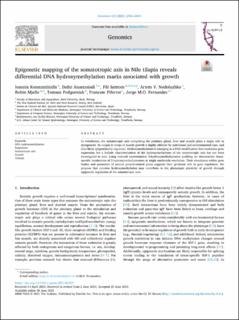| dc.contributor.author | Konstantinidis, Ioannis | |
| dc.contributor.author | Anastasiadi, Dafni | |
| dc.contributor.author | Sætrom, Pål | |
| dc.contributor.author | Nedoluzhko, Artem | |
| dc.contributor.author | Mjelle, Robin | |
| dc.contributor.author | Podgorniak, Tomasz | |
| dc.contributor.author | Piferrer, Francesc | |
| dc.contributor.author | Fernandes, Jorge Manuel de Oliveira | |
| dc.date.accessioned | 2021-07-27T06:46:10Z | |
| dc.date.available | 2021-07-27T06:46:10Z | |
| dc.date.created | 2021-07-03T10:07:51Z | |
| dc.date.issued | 2021 | |
| dc.identifier.citation | Konstantinidis, I., Anastasiadi, D., Sætrom, P., Nedoluzhko, A. V., Mjelle, R., Podgorniak, T., Piferrer, F. & Fernandes, J. M. O. (2021). Epigenetic mapping of the somatotropic axis in Nile tilapia reveals differential DNA hydroxymethylation marks associated with growth. Genomics, 113(5), 2953-2964. doi: | en_US |
| dc.identifier.issn | 1089-8646 | |
| dc.identifier.uri | https://hdl.handle.net/11250/2765312 | |
| dc.description.abstract | In vertebrates, the somatotropic axis comprising the pituitary gland, liver and muscle plays a major role in myogenesis. Its output in terms of muscle growth is highly affected by nutritional and environmental cues, and thus likely epigenetically regulated. Hydroxymethylation is emerging as a DNA modification that modulates gene expression but a holistic characterization of the hydroxymethylome of the somatotropic axis has not been investigated to date. Using reduced representation 5-hydroxymethylcytosine profiling we demonstrate tissue-specific localization of 5-hydroxymethylcytosines at single nucleotide resolution. Their abundance within gene bodies and promoters of several growth-related genes supports their pertinent role in gene regulation. We propose that cytosine hydroxymethylation may contribute to the phenotypic plasticity of growth through epigenetic regulation of the somatotropic axis. | en_US |
| dc.language.iso | eng | en_US |
| dc.publisher | Elsevier | en_US |
| dc.rights | Navngivelse 4.0 Internasjonal | * |
| dc.rights.uri | http://creativecommons.org/licenses/by/4.0/deed.no | * |
| dc.title | Epigenetic mapping of the somatotropic axis in Nile tilapia reveals differential DNA hydroxymethylation marks associated with growth | en_US |
| dc.type | Peer reviewed | en_US |
| dc.type | Journal article | en_US |
| dc.description.version | publishedVersion | en_US |
| dc.rights.holder | © 2021 The Author(s) | en_US |
| dc.subject.nsi | VDP::Matematikk og Naturvitenskap: 400::Basale biofag: 470::Genetikk og genomikk: 474 | en_US |
| dc.subject.nsi | VDP::Matematikk og Naturvitenskap: 400::Zoologiske og botaniske fag: 480::Zoofysiologi og komparativ fysiologi: 483 | en_US |
| dc.source.pagenumber | 2953-2964 | en_US |
| dc.source.volume | 113 | en_US |
| dc.source.journal | Genomics | en_US |
| dc.source.issue | 5 | en_US |
| dc.identifier.doi | 10.1016/j.ygeno.2021.06.037 | |
| dc.identifier.cristin | 1920178 | |
| dc.relation.project | EC/H2020/683210 | en_US |
| dc.relation.project | EC/H2020/812986 | en_US |
| dc.relation.project | Research Council of Norway: 250548 | en_US |

